So, I love Dungeons and Dragons. As such, I read through many different posts in my free time. One that I have been seeing a lot has been pictures of Grimtooth’s DnD traps. Due to this resurgence of DnD traps, I figured I would talk about my favorite part of any dungeon, traps!
DnD Traps: What Are They? How To Build One?
Then what are traps? Well excluding the internet rule 34, traps are devices, either magical or mundane, that are designed to inflict harm on whoever triggers it. This can be your general bear trap or even a warding sigil. When building one for your dungeon, you need to first determine how deadly do you want it. There are three classifications of danger for a trap; Moderate, Dangerous, and Deadly.
Deadly Traps
If you want it to potentially kill a member, take into account your characters level and plan for a deadly device. These do not necessarily have to straight kill them but could also be a trap that locks them into a deadly situation. The classic situation is taking a piece of treasure then watching the doors close behind you. Thus, allowing water to flood in and slowly drown you unless you can stop it. In these situations, you should use these kinds of traps to instill fear into your players’ party, so they treat the situation more seriously.
The other form of deadly DnD traps are those that directly harm. For instance, a poison needle that does 6d6 (21) points of damage is not too dangerous for a level 6 rogue with 33hp. Why it might almost kill him, it most likely will not. That said, a poison needle that did this much damage to a level 3 rogue with 18 hit points, would almost certainly kill him. Making this a deadly DnD trap that can really scare or change a party with no forms of healing.
Now it should be noted, you should never try to directly kill a party member unless the player says they want it. Especially with traps. The reason being, it leaves a sour taste in most people’s mouth and can ruin a game so please use these with caution and always ask yourself, “what happens if they fail?”
Dangerous Traps
A dangerous trap are the most common DnD traps to see in a dungeon. These are designed to do serious damage that has a player really wanting to heal. My favorite trap is the net trap. I often use this against level 1-4 parties as the design is rather simple and used for simple creatures. What this does is if a party member fails to notice a pressure plate, a trap falls from the ceiling. Afterward, they must make a Dexterity save to avoid being caught. But the real danger comes from an alarm going off alerting the residents and causing for a surprise round to go against them. This forces a fight in addition to the trap leading to a more thrilling moment then just a Dexterity save.
DnD traps don’t have to cause fights though to be dangerous. Good use of a dangerous trap is one that puts your people on edge that something else could happen afterward. For example, say your level 7 party pulls the wrong lever causing a chemical explosion happening dealing 8d6 (28) points of damage. Don’t end it there though, describe something like, “the echo from the explosion drifts through the cave. You are unsure if anyone heard it but if so, your presence is most likely known.” This prevents a trap from being a one and done scenario. Rather, it injures the party AND causes secondary effects to make them worry. This is what transforms an okay trap to a great trap for DnD.
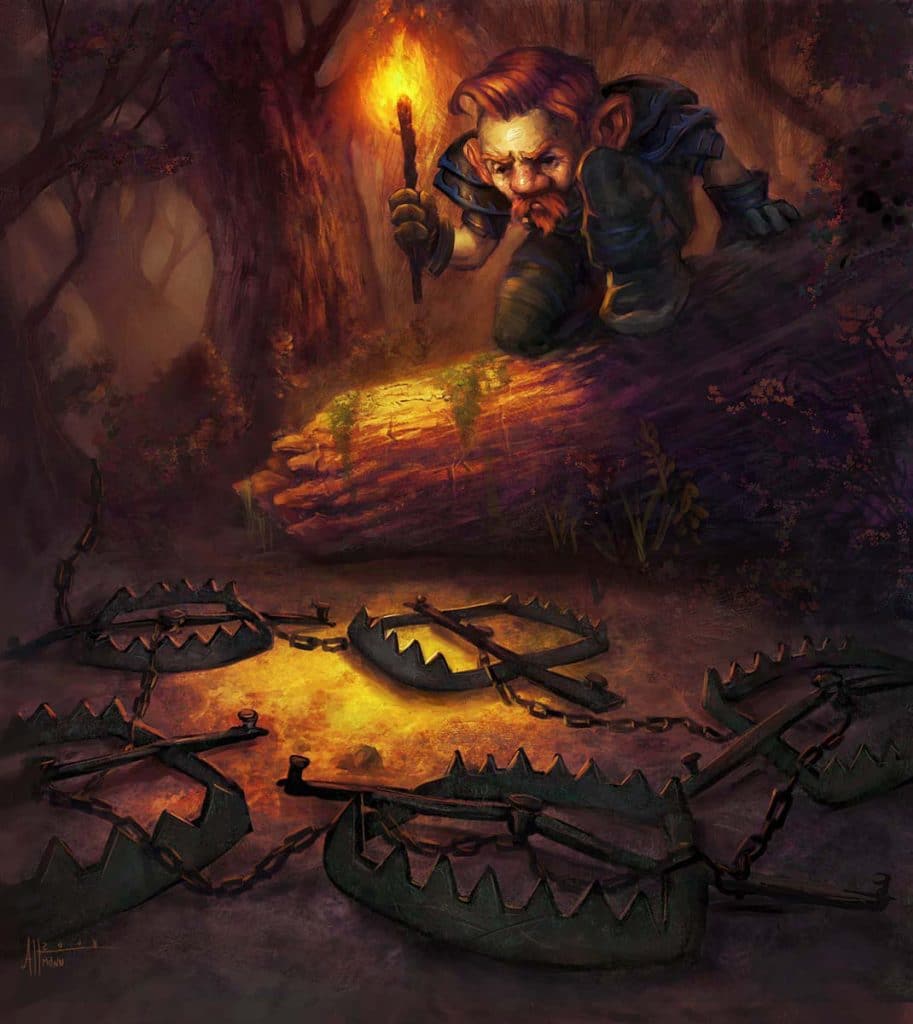
Moderate Traps
If we talked about dangerous and deadly, what makes a trap moderate? I always define a moderate trap as an antics trap. These do low damage and put people at inconveniences. I love these for when I have an NPC that is crazy. They can create memorable moments with your players that get them laughing or be a trap that drives them insane. So, one time I did this with a grease trap. If they were hit, for the next ten minutes I would randomly ask them to beat a DC 10 acrobatics check. If they passed nothing happened, if they failed, they fall prone. Nothing serious but caused for a ton of hilarity among the players as they would constantly goad the prone barbarian who just wanted to walk.
I have also built a dungeon filled with random simple traps that range from a crossbow going off to just hidden bear traps. This led to massive frustration as they constantly were having to disarm or avoid traps. The end result was hilarious as once they got through an hour of traps, that was the end of the dungeon. It was the best April fools prank I have ever done and probably will ever do. Also, don’t worry, I gave them an actual adventure after that which they went completely off course to get back on me. It was a fun day and is what moderate traps are really designed to do. To be fun.
Complex Traps: What Are They And Function?
A very common complaint with traps are that they are one and done. This leads people to really feel a letdown when dungeon crawling. This can be prevented with the above recommendations above. To keep a party fearful with deadly traps, to keep a party worried with dangerous traps, and to keep a party laughing with moderate traps. This should help you with all the DnD traps you design. That said, another very common way to keep traps interesting are complex traps.
What is a complex trap? Great question! A complex trap is a DnD trap that continuously goes off until your party can disarm it. Think of these like a combat encounter. Your entire party is trying to defeat the boss (the trap), and all must work together to do it. My biggest recommendation for these are to have everyone roll initiative with the trap given a preset initiative depending on when it goes off.
A good example would be a trap designed by Matthew Mercer from Critical Role episode 67. Now, if you are watching Critical Role I suggest watching it if you want to avoid spoilers. If you do, either watch it on the link above or skip this section I will bold when I stop talking about the episode.
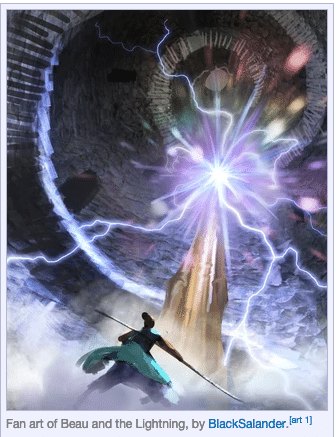
Complex Trap Example: Setting It Off.
In Critical Role, the adventuring party are in a dangerous dungeon trying to find a possible spy for a nation they are allied with. As they continue down the path, they come across a long winding staircase filled with a thick fog. As they walk down the stairs, one of their party members steps on a plate causing the door to slam behind them and a low hum begin forming. The party immediately starts to panic when suddenly a vapor like elemental appears from the fog and swipes at one of the party members.
This is the first step of the trap. A low hum has begun alerting them of the trap, a thick fog covers the place preventing an obstacle, and now there is something dealing harm to them; adding a sense of urgency. These three uses are vital to creating a good trap. It creates a sense of fear, challenge, and urgency creating an intense moment.
Complex Trap Example: Trap Released
Now that the party has overcome their panic, they begin devising a plan. When suddenly, a flash of lightning comes flying through the central stairwell dealing 1d10 points of lightning damage. Now the party knows to go down as fast as they can to defuse the trap. As they continue racing downward unsure how long this is, another lightning attack hits them dealing 2d10 damage as the trap continues to fire up. All the while they are constantly being pestered by the vapor elemental attacking them.
In this sense, we see how the damage continues to increase causing more fear to them. After all 1d10 damage is something but knowing every turn the damage will just get higher? That is much scarier. Also note, how Matthew Mercer uses the vapor elemental to constantly antagonize them and deal damage. This is an effective use of a trap inside a trap as the moderate trap now forces people to decide which one to focus on, as well as creating an obstacle as they attempt to get to the device.
Complex Trap Example: Deactivating The Trap
After racing down the stairs, one of their characters gets to the bottom and sees a large tower, humming with energy and emitting blue light. She immediately wants to investigate it.
Now why some DM’s might just call for an investigation check, Mercer keeps things interesting with his DnD traps, by having them describe what they want to do. This keeps things interesting as now it is not just dice rolls but also forcing them to think how their character would overcome it. For instance, Marisha, the character who sees the tower, begins to investigate it. Mercer asks where she would like to investigate, and she investigates the central part of the tower.
After noticing a blue crystal attached to copper wires in the center, she must come up with a way to deactivate the trap. Her thought process is to remove the power source, so she attempts to grab it. You can see Mercer think of what that would mean and asks her to make a Strength save. After passing her Strength save, she takes damage because she is grabbing the power source directly. This shows that the brute strength can work against a trap just as well as anything else. It should be also noted that there are usually multiple ways to deactivate a complex trap as pigeonholing a DnD trap can lead to people to be upset. Because, when the Bard has a really creative way to overcome something, you want to encourage and reward that idea to allow a better experience for them.
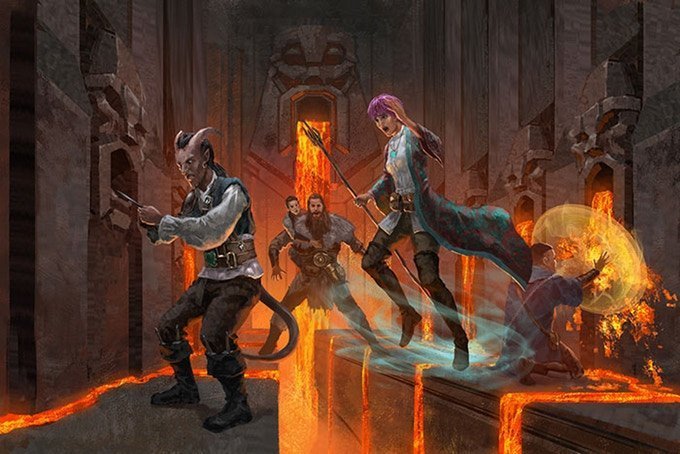
Devising Your Own DnD Traps.
I am now done talking about Critical Role. I have gone over the classifications of traps, as well as shown an example. Hopefully, you are now teeming with ideas on what kind of traps to throw at your party. Yet, you have no idea where to begin besides you know you want a moderate, dangerous or deadly trap. Well, thankfully you are at the spot where I can help you with that.
Remember the Grimtooth DnD traps I mentioned at the beginning? Well, we are actually going to use one of those as the basis in which I will show you how to devise your own trap.
Devising Your Own DnD Trap: Creating Scenarios
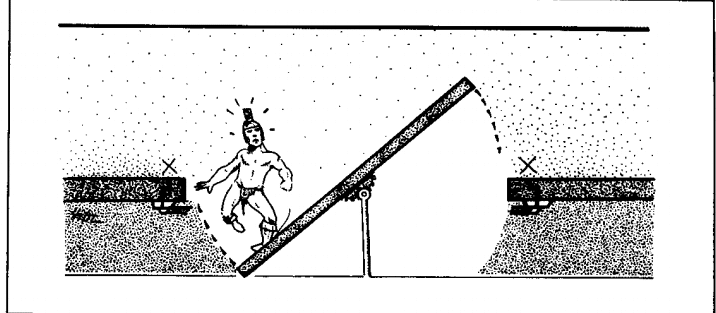
The trap I am using is called “The Last Laugh” trap. It is designed to be a simple floor give away that drops a person into a pit and the floor settles back; trapping you in there. The real kicker though is against the rest of the party. Those that make the save and do not get trapped underneath have the ceiling above them begin to collapse and potentially killing them.
So how would you set this up? Well, the first thing you need to do is determine how noticeable a trap is. For this example, if you wanted the pit to be the big trap, then you should make the perception check to notice the loose floor higher than average. A good DC chart would follow along these lines. A DC 10-14 is an easy trap, DC 15-19 is fairly hard, and a DC 20+ is extremely difficult. Once trapped inside, they must come up with a way to get out of there. But do not just leave it there, make it a challenge for them. Maybe there are slimes down there that are eating away at the dead bodies down there. Now they must figure out how to get out of the pit, as well as dealing with an enemy. Thus, creating a sense of urgency.
Devising Your Own DnD traps: Dealing Damage
If, however, you want to make the ceiling cave in the big trap, then make the floor noticeable with a DC 10 perception check. When one of them notices the decoy, they will attempt to deactivate it causing the cave in. Leading to the party being damaged or potentially killed. In this scenario, you would devise for a rather simple looking solution so no one would get trapped in the pit at first. Then once deactivated, you begin describing that a, “click is heard after you cut the wire. As the wire falls loose a low rumbling begins.”
This creates fear as the party has no idea what is happening. Now to keep them more involved, I would suggest asking them what they would like to do. Giving them one turn to stop something they have no idea what is going on. This creates panic and excitement in the group and gives them no excuses when the rocks fall on them dealing damage.
Now, they have failed to stop the trap, how to determine damage? To determine damage, take into account their level and how deadly you want this to be. Wizard of the Coast have a good guideline to help determine damage. Which can be seen below. For this instance, since we want the cave in to be the big focus, I would devise this as a dangerous encounter for a level 1-4 party. This means the rocks falling would deal 2d10 damage.
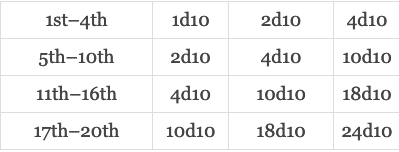
Devising Your Own DnD Traps: Creating Save DC
After deciding on damage, I need to come up with a DC they can make. So as mentioned above a DC 15 is fairly hard. So, to keep this dangerous I would make it probably a DC 15 or 16 for a party. That said, remember how I gave them a turn to try and do something against the trap? I would take this into account. They might have cast a spell that prevented the damage entirely for themselves or the party. If so, I would describe to them how their effects saved them.
In other instances, though, maybe they did something that was helpful but did not stop the trap completely. At this moment, I would lower the DC to probably an 11 or 12. This gives them some satisfaction with what they did but still causes some trouble for them. Which leads to the big takeaway for creating a save DC for DnD traps. Make the DC flexible depending on the party’s actions.
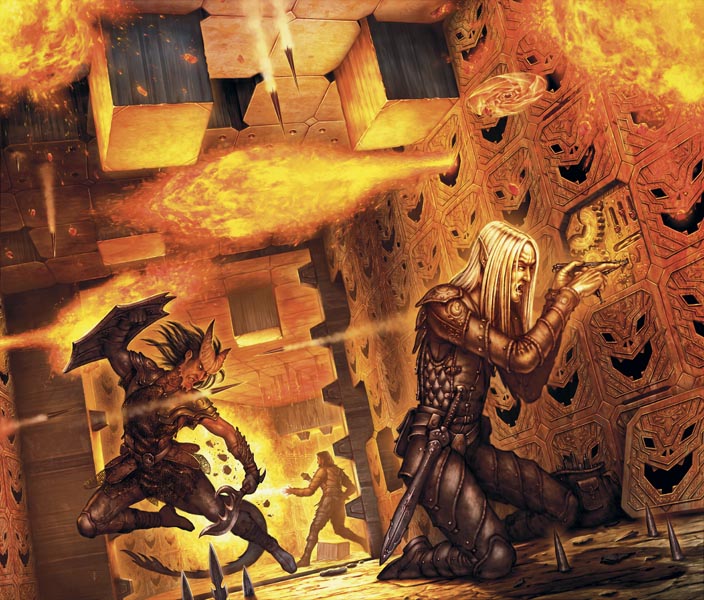
Devising Your Own DnD Traps: After It Went Off.
In my opinion, this is the most important part of a trap. The, “Then What?”. To show you, let us continue the example mentioned above. After setting off the ceiling trap, maybe you describe how the noise echoes throughout the walls and as you turn around to run, your path is cut off by the cave in. Or maybe, you leave the second part of the trap to still be able to be set off. Now they must cross the pit after being damaged. Failure to do so leads to them falling into the pit and seeing the slimes and now must deal with them after being injured.
Then there is the final way to continue after a DnD trap, give them a reward. Maybe another adventurer had died attempting to cross this area and had a scroll of protection on them. This gives you a valuable magical item that rewards your players for experiencing the trap. Thus, leaving them satisfied with the encounter and your party having a memorable experience. Which leads to why this is the biggest part of any trap in DnD. Never leave it one and done, always continue with a “what happens next?”. This will instantly transform any dungeon into a great dungeon by always keeping your party anticipating the next.
DnD Traps: Conclusion
This wraps up my post. I hope you enjoyed as I went over the different ways to build a trap as well as ways to make any trap in DnD memorable. If you liked this post then I suggest you check out my other articles in my homebrew category such as my Seven Popular D&D house rules. They have lots of facts and advice that can really help you if you are new to Dungeons and Dragons, or even an expert.
Or, if you are ready to “reign chaos on your players”, then might I suggest the campaign Dungeon of the Mad Mage? It is one of the new books released by Wizard of the Coast filled with adventure, traps, and madness as you go through 23 levels of a dungeon ranging from level 5 to level 20 characters. I personally recommend adding your own style to it and using one of these levels to create your own personal dungeon. It really makes it a unique and memorable feel to them instead of following a linear path. Well, I hope your day is great and leave a comment with what you thought. I love hearing what you all think. Well, that’s all, so hey, keep on rolling!
- P.S. If you enjoyed this post and others like this, subscribe to my Patreon and help decide on what content will be released as well as get exclusive posts only available to subscribers with all charts used included!

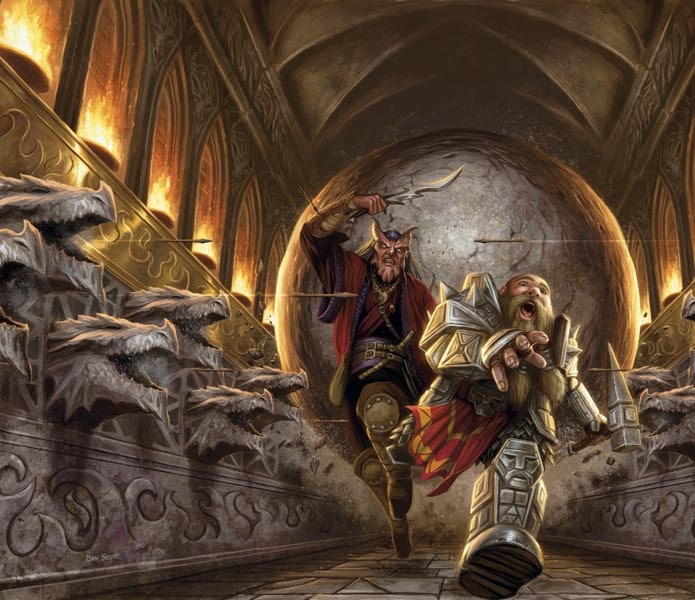
I have always hated traps in dnd as they only seem to get in the way and do nothing for the story. I really like what you were saying about them continuing and setting the mood for a dungeon. Really liked the post and will definitely recommend this article to my DM!
Great to hear! Love knowing you like this post. Be sure to check my website for more content like this to read.